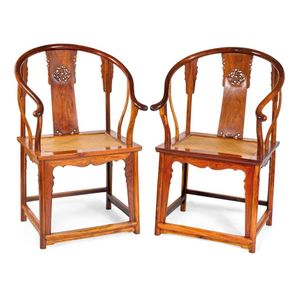Huanghuali Horseshoe-Back Armchairs, Qing Dynasty (2)
You must be a subscriber, and be logged in to view price and dealer details.
Subscribe Now to view actual auction price for this item
When you subscribe, you have the option of setting the currency in which to display prices to $Au, $US, $NZ or Stg.
- Huanghuali Wood - Huanghuali is the most sought-after timber used in the construction of Chinese furniture because of its fine colour and grain.
During Ming and early Qing dynasties, most of the best furniture was made from huanghuali wood.
It is a member of the rosewood family and over time the surface mellows to a yellowish brown tone with the exposure to light.
In recent years, furniture made from huanghuali wood has increased exponentially in value. - Ming Dynasty - The Ming Dynasty was a ruling dynasty of China from 1368 to 1644. It succeeded the Yuan Dynasty and preceded the Qing Dynasty. The Ming Dynasty was established by Zhu Yuanzhang, a former Buddhist monk who became a rebel leader and eventually overthrew the Mongol Yuan Dynasty. During the Ming Dynasty, China experienced a period of relative stability and prosperity. The government was centralized and bureaucratic, with the emperor at the top of the hierarchy. The Ming Dynasty is known for its cultural achievements, including the development of porcelain, the invention of movable type printing, and the construction of the Great Wall of China.
- Cartouche - An ornamental panel in the form of of a shield, oval or rectangular scroll with curling edges. It may be carved into the back of a chair or the top of a sideboard, or present on a piece of silver or jewellery, and contain the initials of the original owner, heraldic symbols, or some other inscription, such as the details of a presentation.
In ceramics the term defines the central area of a vase or similar with a decorative border in one of the shapes above, into which a decorative scene or figures have been painted. - Qing Dynasty - The Qing Dynasty was the last imperial dynasty of China, ruling from 1644 to 1912. It was established by the Manchu people, who originated from the northeastern region of China. The Qing Dynasty was preceded by the Ming Dynasty and followed by the Republic of China.
- Kylin or Qilin - A kylin or qilin is a mythical Chinese animal, dating back to the 5th century with the head of a dragon, the body of a deer and the tail of a lion. It is a regarded as a good omen bringing serenity and prosperity, and is said to appear with the coming or departure of a wise sage or illustrious ruler.
It is also part of the culture of Korea and Japan.
As well as being represented in bronze and jade, it is also used as a decorative motif on ceramics.
This item has been included into following indexes:
- Chinese antiquities by dynasty - Ming Dynasty 1,266
- Chinese furniture, chairs
- Chinese furniture, timbers - huanghuali wood 159
Visually similar items

A pair of huanghuali horseshoe-back arm chairs, Quanyi, (2), each chair with five-segmented rounded crestrail set on straight back posts with beaded shaped flanges, centred with a slightly arched rectangular splat pierced with a ruyi -shaped dragon cartouc

A pair of hardwood horseshoe-back armchairs, Quanyi, (2), each chair with five-segmented rounded crestrail, set on straight back posts with shaped flanges, centred with a rectangular S-form splat carved with a dragon medallion above a panel enclosing an in

Pair of Chinese rosewood throne chairs with rattan seats, 20th century

A pair of huanghuali horseshoe-back armchairs, Quanyi Qing dynasty, (2), each with a rounded crestrail composed of five joined members applied with four metal bands, and set on straight back posts centred with a plain rectangular S-form splat, supported by
